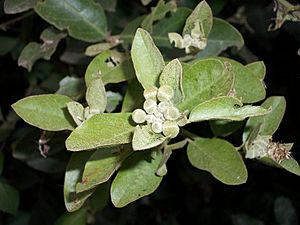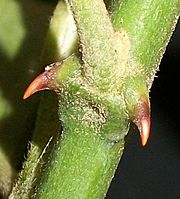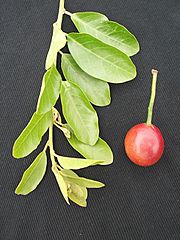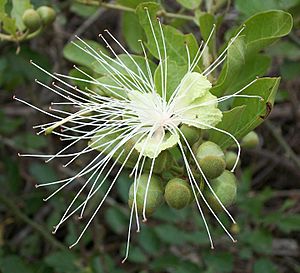Woolly caper bush facts for kids
Quick facts for kids Woolly caper bush |
|
|---|---|
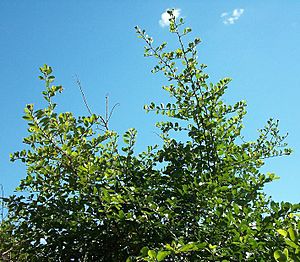 |
|
| The Woolly Caper Bush growing as a shrub in Amanzimtoti, South Africa | |
| Scientific classification | |
| Genus: |
Capparis
|
| Species: |
tomentosa
|
| Synonyms | |
|
|
The Capparis tomentosa, also known as the Woolly Caper Bush or African Caper, is a plant that belongs to the Capparaceae family. It is originally from Africa. This plant is known for its interesting features, from its sharp thorns to its beautiful flowers and fruits.
Contents
Where the Woolly Caper Bush Grows
The Woolly Caper Bush can be found in many parts of Africa. It grows in bushy areas and forests. You can see it from the Eastern Cape in South Africa, all the way through KwaZulu-Natal, Mpumalanga, and Limpopo. It also grows in countries like Mozambique, Botswana, and Namibia.
Further north, its range extends from Senegal to Eritrea. You can even find this plant on the Mascarene Islands, which are in the Indian Ocean.
What the Woolly Caper Bush Looks Like
How it Grows
The Woolly Caper Bush is usually a strong, woody plant that climbs. In areas near rivers, it can grow very tall, reaching the top of the tree canopy. Sometimes, it can also be a sprawling shrub or even a small tree.
Stems and Thorns
The stem of this plant has sharp, hooked thorns that grow in pairs. When the stems and thorns are young, they are covered in soft, yellowish hairs, making them feel velvety.
Leaves
The leaves grow between the thorns. They are usually long and oval-shaped, about 30-80 mm long and 15-25 mm wide. They are a grayish-olive green color and can be covered in soft, velvety hairs or sometimes be smooth. The edges of the leaves are smooth and often curl under. The leaf stalk, called a petiole, is about 4-12 mm long and also feels velvety.
Flowers
The flowers of the Woolly Caper Bush grow in clusters. They can be found at the ends of branches or on short side branches. Sometimes, they appear in the upper parts where leaves join the stem. These flowers are large, about 35 mm across, and have a lovely scent.
They have many pinkish-white stamens, which are the parts that produce pollen. Each stamen is quite long, about 20-35 mm, and can be crimson (dark red) at the bottom. The sepals, which protect the flower bud, are shaped like boats and are 8-10 mm long. The petals are whitish, about 15-25 mm long and 7-10 mm wide.
Fruit
The fruits hang from a long, stalk-like part called a gynophore, which can be 25-50 mm long. The fruits themselves can be up to 40 mm (or even 50 mm) wide. They start as shiny green and turn pink or orange when they are ripe. Inside, the fruit contains many seeds surrounded by a pinkish flesh. Sometimes, you can see dried-out, empty fruits still hanging on the plant for a long time.
Safety for Animals
It's important to know that parts of the Woolly Caper Bush can be harmful to animals if they eat too much of it. Studies have shown that animals like Desert sheep, zebu calves, and Nubian goats can get sick if they eat the leaves.
Animals that have eaten the plant might show signs like weakness in their back legs, staggering, and pain. They might also lose their appetite and lie down a lot. This is why farmers need to be careful if this plant grows where their animals graze. Scientists have found certain natural chemicals in the plant that can cause these problems.
How People Use the Plant
People in Africa have used the Woolly Caper Bush for a long time in traditional medicine and for other special purposes. For example, it has been used to help with problems like diarrhea, swelling, and water retention in the body.
This plant is also used as a decorative plant in gardens. Because of its sharp, hooked thorns, it can be planted to create a natural security fence, helping to keep unwanted visitors out. The fruit of the Woolly Caper Bush can sometimes be eaten by people.
Animals and the Woolly Caper Bush
The Woolly Caper Bush is important for many animals in its environment. Several types of butterflies use this plant as a place for their caterpillars to eat and grow. These include butterflies like Belenois gidica, Dixeia pigea, Eronia leda, and Colotis evenina.
Larger animals, like game animals, eat the leaves of the plant. Monkeys and bushpigs enjoy eating the fruit. This shows how the Woolly Caper Bush plays a role in the local ecosystem.
See also
 In Spanish: Capparis tomentosa para niños
In Spanish: Capparis tomentosa para niños


